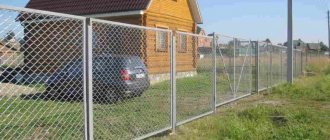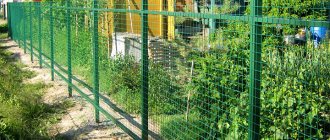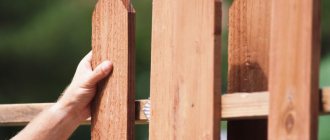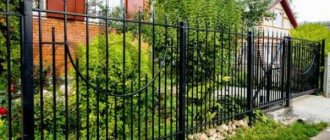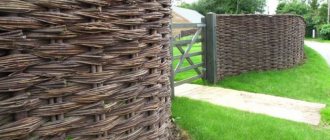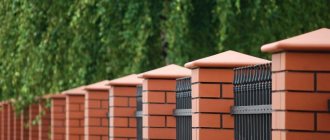A simple and inexpensive way to mark property boundaries is to install a chain-link fence. Of course, today there are many alternative materials that have a more presentable appearance, for example, a fence made of corrugated board. But they are more expensive and labor-intensive to install, and are more suitable for permanent external fencing of a country house.
What if you need to fence off a building plot, a summer cottage, separate a business area from a residential area, or make an enclosure for animals?
Is it wise to spend a lot of money and a lot of time, attracting specialists, if you can make a fence from a chain-link mesh with your own hands in one day, and the result will be achieved? The manufacturing technology, calculation and installation are described below in the form of step-by-step instructions.
Popular, inexpensive - chain-link fence
Whatever this fence is called, it has a significant number of positive aspects. The first and most important advantage is low cost. This applies to both the filling itself—the mesh—and the rest of the structure. To tension the mesh, no foundation is required. It is enough to drill holes about a meter, insert a post and, filling it with crushed stone, compact it well. That's it, no concrete work. On most soils, this method of installation for this filling works “five”.
General information about chain-link mesh
The name of the material comes from the name of its inventor, Karl Rabitz. For the first time, he began to use mesh instead of a shingle lattice to strengthen the plaster layer. Today the invention is used as a material for fencing.
The material for making the mesh is low-carbon mesh with a diameter of 1 to 6.5 mm. The size of the cells and the area of application depend on the material used. Thus, a mesh made of large cells is used for various fencing, and a fine mesh made of thin wire is used to build enclosures or cages for animals or birds. Also, to create fences within the territory or to separate areas between neighbors, a mesh made of polymer materials is used. It cannot withstand heavy loads, and more often serves a decorative function.
Plastic chain-link is used more often for decorative purposes.
Characteristics and features by type
Fences can be classified according to their planned durability: primary, temporary, final.
The primary one is placed in the first days of the new owner’s appearance on his site. It's more of a virtual fence than a physical one. Planning of the territory begins, delivery of building materials, their storage, digging of the first beds and flower beds. The owner of the site and his neighbors begin to get used to the boundaries of their own and other people's property.
Usually, in the second year of owning a plot, the owner has the need and opportunity to put a more solid fence around the plot. He naively thinks that this will be a temporary option, and only then he will do everything to the highest standard. Often these plans remain unrealized. True, the fence posts, even though they are temporary, are solid – concrete or metal. But so far there are neither hands nor funds for a solid fence. This is where the mesh comes in handy. It can be either plastic or metal - it all depends on the budget.
A solid, eternal fence is erected by the owner who has the means to do so and who has something to protect.
Mesh fencing can be classified according to its functionality, taking into account its purpose.
Combining two types of mesh - chain-link and plastic PHOTO: zaborsebe.ru
Decorative options
There are many types of façade mesh available on the market, which can be used for decorative purposes. When used, the fence not only protects, but also pleases the eye with color, shape or pattern. The meshes vary in color, thread thickness, and cell shape.
Related article:
Camouflage mesh for fence
The camouflage net was originally intended for military and sports purposes. The military uses it for its intended purpose - as camouflage when covering objects and personnel. They are used as decoration in the design of thematic exhibitions, stage areas and for other similar purposes. Popular with hunters. But inventive summer residents use such products for both utilitarian and decorative purposes. Attracts buyers with a relatively low price.
Made from textile material coated with polyurethane. There is an option made on the basis of a woven network, with pieces of fabric glued to it. Has an unlimited service life. The mesh material does not collapse under the influence of ultraviolet rays, is waterproof, and protected from rot and mold.
Fencing made of camouflage mesh PHOTO: yandex.ru
Shading mesh for fence
It is called shading because gardeners use it to protect delicate plantings from excess sunlight. It is from excess, and not from light in general. The net has a large mesh; when fencing sports fields, it does not interfere with watching the sports action and well separates spectators and players. And installers will use it on scaffolding to catch objects falling down. The mesh is very durable and can be used many times.
Construction site fencing mesh
Fencing of construction sites is carried out in different ways. Firstly, this fencing is temporary in nature - construction must end someday. Secondly, such fences have different appearances and different installation technologies. It can be mounted on portable stands, or on embedded posts.
Durable plastic mesh is extruded from a combination of polymers. Retains its physical and mechanical properties in the temperature range from -40ºС to +50ºС. Cell size 45×90 mm.
Polypropylene mesh is used not only on construction sites, but also for fencing ski slopes - at forks and turns. Cell size 40×45 mm.
Fences in the city are often made of banner mesh. This is a canvas with a thematic pattern, reinforced with polyester thread for strength. The use of such a solution is carried out with the aim of increasing the aesthetics of the urban landscape.
Construction site fencing PHOTO: yandex.ru
Banner mesh fencing PHOTO: setka77.ru
Advantages of a chain-link fence
- Relatively low cost. The variety of types of finished product allows you to save on the fence.
- Installing a fence is quite simple; a person without professional skills can handle this task.
- If the mesh is made of galvanized wire, its service life will exceed 50 years.
- To enhance the reliability of the structure, barbed wire can be stretched along the edge.
- Chain-link mesh is a good fencing option for areas with large vegetation. It allows sunlight, moisture and air to pass through, which is beneficial for garden plants.
- Using this material, you can divide the area into functional zones.
Very often, mesh is used to create temporary fences.
Advantages and disadvantages of plastic mesh for a budget fence
This type of fence material has a number of advantages, including:
- affordable price. Plastic fence mesh is a suitable option when installing a fence around a dacha;
- Possibility of transportation in a rolled state. Due to its small dimensions, the material is easily transported;
- not afraid of exposure to precipitation. Polymer fence mesh does not rot under the influence of rain and snow;
- ability to withstand sufficiently large external pressure;
- possibility of self-installation without the use of expensive equipment and tools;
- the grid does not light up;
- the material does not have a harmful effect on the environment;
- presented in a large assortment. Depending on the overall stylistic design of the dacha, you can choose the appropriate weaving option, color and cell size.
Among the disadvantages of plastic garden fence mesh it is worth noting:
- limited service life, which is about 5 years. And this is provided that it is not subject to mechanical stress. The plastic façade mesh is damaged by sharp objects or high pressure;
- transparency. When growing various vegetables in the country, this property is an advantage. If you don’t want to advertise your personal life, then this is a drawback.
Green fencing mesh is the most popular option.
Methods for installing chain-link mesh
In order to make a fence from a chain-link mesh, you need to prepare the mesh itself, posts and wire 3 mm in diameter. As supports, you can take wooden logs, metal and asbestos-cement pipes, or pillars made of concrete or metal. They must be placed at a distance of 2.5 m. To figure out how to attach the chain-link mesh to metal poles, you should pay attention to special hooks that must be fixed on the pole before installation. The installation technology depends on the characteristics of the site, budget and purpose of the fence.
To install the mesh, you can choose any convenient method
Tension fence without guides
All types of supports except stone or brick are suitable for this method. The canvas is simply pulled between the supports and simply secured with wire or hooks. This technology is used to divide a site into zones or for short-term fencing.
Tension fence using guides
To install such a fence, additional supports are used. You can use a metal profile or wooden beam. The result is a structure made of pillars and horizontal metal elements welded to them. This technology cannot be used on heaving soils.
Using it lightly will not allow the canvas to sag
Sectional fence
The technology involves creating sections from corners using welding and filling the space with a mesh sheet. Such fences can be installed in areas with uneven terrain. For each individual section, frames with different widths or heights can be made.
Types of mesh
Even the simplest material can have different purposes. Various technologies are used to produce chain-link mesh.
Mesh made of black wire
This is the cheapest low quality option. After moisture gets on the surface, the metal immediately begins to rust, and after 3-4 years of operation it becomes unusable. To extend the service life, before installation, the surface is covered with liquid rubber or paint. This type of material is more often used as reinforcement for plaster.
This material is resistant to moisture
Galvanized wire mesh
This version of the building material is not afraid of corrosion, thanks to the protective zinc coating. It has a more attractive appearance and does not require additional coating.
A fence made of galvanized mesh will last more than 15 years
Polymer coated wire mesh
A dense layer of polymer protects the metal wire from moisture or weather conditions. Typically, a colored polymer is used for coating, which gives the fence a more aesthetic appearance. This building material is a little more expensive, but the quality justifies the cost.
Polymer coating protects the wire from corrosion and increases service life
Plastic mesh
The material used to make the canvas is polymer. To ensure resistance to ultraviolet radiation, special substances are added to the material. This fabric is suitable for a fence between areas, but the mesh should not be used for street fencing due to insufficient strength.
The service life of plastic mesh is significantly shorter than metal mesh
In addition to quality, the price of the mesh is affected by the mesh size, wire diameter and roll height. The wire diameter can be from 1 to 5 mm, the cells can have a size from 10 to 65 mm, and the roll height can range from 80 cm to 2 m. The most popular mesh is with a height of 1.5 m. The standard roll length is 10 m. The finer it is. mesh, the higher its cost.
Also on sale are options for mesh stretched over rectangular sections. The metal frame is made of round pipes and metal corners. This option will not sag and will give the fence a more aesthetic appearance.
Installation of ready-made sections simplifies work
When choosing a material, you should pay attention to the thickness and quality of the wire, the absence of deformations, and how even the pattern of cells is. When choosing meshes with a polymer coating, or entirely made of plastic, you should ask for a quality certificate and find out the warranty period for the product. High-quality material lasts at least ten years. Cheaper options begin to crumble under the influence of ultraviolet radiation in the second or third year.
The mesh must have an even cell pattern and be free of defects
Calculation of the amount of mesh for a fence
Before building a fence, you need to determine in advance how many posts and linear meters of material you will need. To do this, it is worth considering the following points:
- The length of the chain-link should be calculated based on the total length of the fence. Most often, the mesh is usually supplied in rolls of 10 m.
- The number of supports is determined according to the same principle, but it is important to take into account the distance between them. It should not exceed 2–2.5 m. Moreover, this rule applies regardless of the method of attaching the mesh.
- In the tension version of the design, the length of the wire is equal to two lengths of the future fence.
- When assembling sectionally, in order to calculate the length of the profile corner, it is necessary to multiply the perimeter of the frame by the number of sections.
Scheme of installation of poles and fastening of the mesh.
The average price for non-galvanized chain-link with dimensions 50*50*2 mm starts from 45 rubles. for 1 sq. m, galvanized - from 56 rub. for 1 sq. m, with polymer coating - 220 rub. for 1 sq. m.
Support material
At the planning stage, the problem of which posts are needed for a chain-link fence is solved. They must have such qualities as reliability, long service life, accessibility and ease of fastening.
Wooden pillars
This material is considered the most comfortable. The canvas can even be secured with ordinary nails, staples or wire. Since the material is susceptible to rotting, the surface of the logs must be treated with special compounds, the underground part of the support should be waterproofed, and the above-ground part should be regularly painted. For wooden supports, timber with a cross section of 100x100 mm or round timber with the same diameter are suitable.
Wood is the most convenient material for supports
Metal supports
For this purpose, a profile with a cross-section of at least 25x40 mm or pipes with a diameter of 60 mm or more is suitable. In this case, the thickness of the metal must be at least 2 mm. The advantages of metal supports include durability, resistance to corrosion, the ability to use a welding machine for fastening fencing elements, and an aesthetic appearance. To extend the service life, the metal surface is cleaned of scorch and rust, coated with an anti-corrosion compound, primer mixture and paint. To prevent precipitation from getting inside the pole, which can lead to corrosion, it is worth using special plugs. If a problem arises, how to install a chain-link mesh on metal poles without a welding machine, then you can purchase ready-made supports with hooks. There are also other ways to solve the problem of how to attach a chain-link mesh to metal posts. You can use clamps or wire.
All supports must be level
Concrete supports
It is quite difficult to attach a canvas to a concrete pillar, and the process of manufacturing, delivery and installation of supports is quite labor-intensive and requires the use of special equipment. For these reasons, such support material is rarely used. Despite these disadvantages, reinforced concrete supports are very reliable and do not require maintenance.
Concrete supports are difficult to install
Asbestos cement pipe
Such supports do not require large investments, but you need to know how to properly install the chain-link mesh on the posts. For these purposes, wire clamps or twists are usually used. When the temperature changes, the water inside the pipe can easily destroy it. Special plugs are used for protection.
Asbestos cement pipes need protection from moisture
Pillars made of stone or brick
This is one of the most aesthetic types of supports. For their construction it is necessary to use not only brick or stone, but also concrete. Also, do not forget about the embedded parts to which the sections will be attached.
Installing stone or brick pillars will take more time
Stages of installing a chain-link fence
Site preparation and installation of corner posts
The location of the fence should be cleared of vegetation and, if possible, leveled. After this, it is worth deciding on the location of the corner posts. They should have a larger diameter and height than the others.
Before starting installation, you should clear the area of debris and, if possible, level the surface
Installation of supports
Pipes or logs must be clean and dry. In the soil at the location of future supports, you need to make holes 1.5 m deep. Sand is poured onto the bottom and compacted. Pillars are placed in the hole and fixed vertically using available materials. Crushed stone is mixed with soil and the hole is filled with this mixture to 2/3 of the depth. The mixture is thoroughly compacted. After this, fill the hole with crushed stone and fill the hole with a cement mixture. After all actions, the verticality of the pillars is re-checked using a level. If necessary, they are leveled again. After the concrete mixture has hardened, the spacers are removed and markings are made for the intermediate pillars.
Fixing the metal support while the concrete hardens
Marking
To simplify the work, a rope is pulled between the installed supports at a small height from the ground. In the future there will be a fence here. The number of intermediate supports is also determined. The distance should not exceed 2.5 m, otherwise the mesh will begin to sag. At the site of the future pillars, pegs are driven into the ground and touch the rope. Also, do not forget about the placement of posts for wickets and gates.
Installation of metal support
Installation of supports
Intermediate posts are installed at the signage site using the same technology as corner posts. If the fence is not sectional, but tensioned, and the soil on the site is of sufficient density, then you can do without concreting the intermediate supports.
Installation of hooks
For mesh fencing, supports with ready-made hooks are sold. You can also weld them yourself. Nails or wire are usually used for this purpose.
On a pipe 2 m high, 3 hooks are placed - the first at a height of 15 cm from the surface, the second at a distance of 10 cm from the top edge, and the third in the middle between them.
Attaching the canvas to the profile
Sometimes situations arise when it is impossible to use welding. In order to solve the problem of how to attach a chain-link mesh to metal posts without welding, you should use clamps. If the posts are wooden, the clamps can be replaced with nails. They are driven in at the bottom, at the top, and bent, while securing the wire.
Option for fastening the canvas to wood
Mesh installation
You should start pulling the mesh from the post that stands in the corner. For reliable fixation, a one and a half meter reinforcement with a cross section of 8 mm is inserted into the first row of holes and welded to the pipe. After this, the fabric is unwound and the hooks are threaded into the cells. In order to figure out how to stretch a chain-link mesh onto a fence, you do not need to have professional skills. It is enough to unwind the roll from one support to the next and securely fix the web. Corner pillars should not be lined with canvas. It is worth cutting it and fixing each part separately.
The canvas must be securely fixed
For those who are interested in the question of how to attach a chain-link mesh to a profile pipe in a more reliable way, it is worth using fixing metal attachments. Holes for hardware are drilled in the nozzles and posts. After stretching the fabric, the blanks are connected to the posts with hardware, and their caps are riveted. This method of fixation is the most reliable, but at the same time it is quite difficult to dismantle the fence without damaging the canvas.
Video description of installing a chain-link mesh with your own hands
An example of a simple installation of a chain-link mesh in the video:
Fastening the canvas to avoid sagging
Each mesh fence requires additional fixation. To do this, take a wire with a cross section of 6 mm. It is threaded through the third row of holes from the top and welded to metal supports. Thus, you should stretch and fix the wire from below. After fixation, all hooks are bent.
Additional fixation
If the owners of the site are wondering how to make a chain-link fence with their own hands without welding, then for the fence it is worth using poles made of wood, concrete, or asbestos pipes.
Installation of a sectional fence
If you have a question about how to make a chain-link fence with your own hands, then you should carefully study the instructions for installing it.
Manufacturing of sections
For metal frames, corners of 40x50 mm are used. A rectangular frame is made from them. The dimensions of the frame must correspond to the dimensions of the spans. In this case, the width should be 15 cm less than the span, and the height should be 10 cm below the support. To fix the mesh in the frame, reinforcement with a cross-section of 8 mm is used. Using a grinder, cut out the desired rectangle from the mesh, thread a reinforcing rod through the holes and weld it to the inside of the frame. The finished section is sanded, cleaned and coated with primer.
Sections of any size can be made
Installation of racks
For the posts, rectangles made of 4 mm steel with dimensions of 20x5 cm are used. They are welded to each post at a distance of 20 cm from the soil surface and 20 cm from the top edge.
Installation of sections
Each section is leveled and welded to the plates. It is very important to ensure that the tops of the frames are one line. After completing the welding work, all traces of welding must be cleaned, covered with a primer and the frame covered with a layer of paint.
A sectional fence has a more beautiful appearance than just a stretched fabric, and you don’t need to wonder how to stretch a chain-link mesh onto a fence alone.
This is what the installed section should look like
What is a photo grid for a fence
The technology has been known for a long time - it is used in the production of banner advertising or for printing photo wallpapers. But they began to use such materials to decorate fences quite recently. The photographic image is applied either to banner fabric or to reinforced PVC mesh. It’s difficult to say what’s better: you can choose based on each situation.
In the case of chain-link fences, it is better to use photo mesh rather than fabric. It is “perforated” - the cell size is 1 mm. This allows both light and wind to pass through. For this reason, if it creates additional windage, it is insignificant. Even poles installed simply in holes with crushed stone, without concreting, will carry it normally.
This is what a photo grid for a fence looks like
The second advantage of a photo grid for a fence is that it allows light to pass through. And if your fence stands on the boundary with your neighbor, he will have no reason to complain that your fence is shading his plantings: it lets in enough light. At the same time, a very small cell significantly reduces the visibility of your area: a simple grid without a pattern is visible by 35%, and with a pattern applied, almost nothing is visible. Even the silhouettes are difficult to distinguish.
Photo fences made of banner fabric are good if you decide to decorate the back side of a fence made of corrugated board. A dull gray or shiny surface is not only not pleasing to the eye. It also harms nearby plantings: the metal heats up in the sun and burns everything that is planted nearby. In this case, there is no need to let sunlight through. Banner fabric with photo printing stretched over such a fence will reflect or absorb most of the solar heat. As a result, the metal will heat up less, and plants near the fence will grow well.
You can also decorate the back side of a fence made of corrugated sheets with a photo grid.
Temperature range of use is from -40°C to +70°C. The declared service life is unlimited, the warranty period is from 5 years. Approximate price - 500 rub/sq.m; 800 rubles per linear piece with a width of 160 cm. Most companies offer a gallery of images that they can transfer to the mesh; some can print any image.
Rolled photo grid is rolled out as a continuous sheet
There are two forms of release: in a roll of a certain height (usually 160 and 180 cm) or in canvases - fragments of 160 * 250 cm or 160 * 300 cm.
Painting the fence
In order to increase the service life of the fence, you need to know how to paint the chain-link mesh on the fence. There are several ways to solve this problem.
Painting with a brush
This is a fairly economical method, although its implementation will require a lot of effort and time. If you work carefully, the amount of paint spilled will be insignificant.
The easiest way to paint
Using a mitten
This is a rather interesting method that is highly effective. It consists of dipping an inverted fur mitten into paint and using it as a brush. To protect the skin on your hands, you should use thin rubber gloves. It is important to know that a high percentage of solvent in the paint can react chemically with the glove material. This method is most successful when using oil paints.
Painting using a spray gun
Using this method, the mesh will be painted in an even layer in record time. In this case, the jet should be kept at an angle of 45°, which is quite difficult. Also, the disadvantages include the unreasonably high consumption of paint.
Painting with a roller
This technology is considered the most optimal, especially if two people paint the mesh on both sides at the same time. For the most uniform coverage, you should choose a roller with a longer pile.
It is also worth considering that before painting you should remove the rust and cover the surface with a primer.
How to decorate a mesh fence
Very often, after you have made a chain-link fence with your own hands, there is a desire to refine it and give it a more attractive look. Several methods can be used to achieve this goal. Using mats or polycarbonate sheets will help not only decorate the fence, but also make the area more private for a long period of time. The use of other technologies will help solve the problem for one season, but this gives the opportunity to experiment and implement creative ideas every year.
You can use any materials for decoration
Hedge
With the help of plants you can create various compositions. The green mass will provide an opportunity to avoid prying eyes throughout the summer season. This method is relatively inexpensive and attracts with quick results.
Using Perennials for Living Fencing
Morning glory is considered the most successful plant for a hedge. It not only grows quickly, but also has beautiful large flowers that open buds early in the morning before the heat sets in. This method has one drawback - you need to take care of the plant, and with the onset of autumn, remove dry stems from the entire fence.
Morning glory very quickly fills the space with its shoots
Camouflage mesh
This method will help to quickly and permanently hide the territory of the site from prying eyes, and will not interfere with the penetration of air or sunlight. A wide variety of colors allows you to choose the most suitable option. The nylon base makes the structure very durable.
Camouflage mesh does not darken the area
Using a Shading Grid
This material is used to darken chain-link fencing. The installation process is quite simple and does not cause any difficulties. There is a wide variety of such meshes on sale, from transparent to those that darken the canvas by 100%.
Shade material needs to be changed every year
Artificial needles
This material makes it possible to decorate the fence in a short period of time and will provide privacy on the site from the curiosity of passers-by and neighbors. The material is sold in rolls, which simplifies the installation process. It is also worth remembering that the service life of needles is one season.
Needles for decorating the mesh
Embroidery from various patches and bags
This method requires a lot of time, but as a result you can get a unique fence. Before you start, you need to create a composition.
Embroidery pattern on a fence
Using reeds
If the previous ideas are not suitable for solving the problem of how to make a chain-link fence more beautiful, then you should use ordinary reeds. This is a natural material that, for little money, will make it possible to create a dense screen and block the area from curious passers-by. Despite the fact that reed is a grass, it is quite durable and is sold in the form of rolls or mats, ready for use.
Reed is an environmentally friendly material that does not require disposal
Polycarbonate sheets
If the question arises of how to make a continuous mesh fence, then you should use polycrabonate sheets. There are transparent and opaque options available in different colors. To design a fence, it is enough to purchase ready-made sheets and install them immediately. Polycarbonate is not only distinguished by its presentable appearance, but also by its long service life.
Polycarbonate will protect the area from strong winds
What is the best fence to choose for your dacha?
There are a wide variety of options on the market now. We talked about them in the article “The higher the fence, the better the neighbors. What fence should I put up in 2022? We, like most consumers, give preference to metal mesh fencing. The simplest and most popular solution is to install a mesh fence from the well-known chain-link . Indeed, the low price of the materials used in production speaks in its favor.
How difficult is it to install such a fence at your dacha yourself or is it worth hiring a team of craftsmen? This is where you need to look very carefully and only then decide what kind of fencing you want to see on your site, whether you will install it yourself or should you invite specialists.
There are several types of chain-link fences and they are classified according to the installation method.

